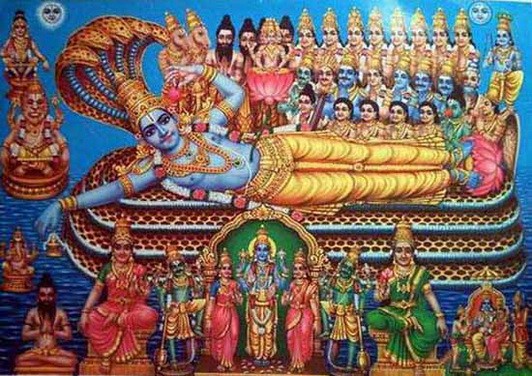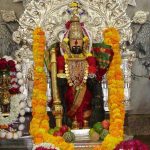Significance of Dhanurmasam – A Month of Devotion
Hindu religion has always devoted its months to certain traditions and rituals, which are not just about praying the Gods, but helps in leading a life that has scientific reasons for healthy and happy functioning. It is mostly based on the climatic changes that happen and these rituals help us to face these changes and get ourselves adjusted to the changing times.
Dhanurmasam is considered the month of Bhakti. This year Dhanurmasam begins on December 16, 2017 and ends on January 13, 2018. Though it is considered an inauspicious month to start any new ventures like weddings and house warming ceremonies, it is also an important month for all spiritual seekers as it is a very good period to worship of Lord Vishnu.
According to Hindu religion, Gods’ day is equal to 6 human months (Uttarayana) and the Gods’ night is equal to the other 6 months (Dakshinayana) in a human year. Dhanurmasam falls at the end of Dakshinayana, or the Gods’ night time. In fact, this month is considered to be the auspicious early hours of dawn for the Devas. It is called Brahmamuhurtam for the Gods and so it is recommended that we perform our prayers and worship during the early hours of the morning, around two hours before the sunrise.
Must Read : Ayyappa Swamy : A 41-day Vratha Deeksha for self transformation
One of the most common practices is to chant Vishnu Sahasranama, Purusha Suktam, Sri Vishnu Suktam or Narayana Upanishad during early morning hours. Many people also offer worship to Sri Maha Lakshmi along with Sri Maha Vishnu during this time.

Legend behind Dhanurmasam
Once, on the eve of Dakshinaayana, the celestials assembled on the peaks of Mountain Meru and prayed to the Upendra form of Lord Vishnu. When the Lord arrived, the celestials told Him that their “night” was approaching and sought His permission to go to their respective abodes. Then Ratri Devi, the patron deity of night and Dakshinaayana, took on the form of a beautiful damsel and prostrated before the Lord. She pleaded with Him as follows “Lord, everybody views dakshinaayana as a bad time. Nobody performs any good deeds in that period. I am universally reviled. I will undertake penance to obtain your grace. If I do not achieve my goal, I will commit suicide and end this life of infamy”.
The assembled celestials concurred and pleaded her case before the Lord. The merciful Lord took pity on her and blessed her as follows, “Ratri devi, your duration consists of 3 seasons of 2 months each. Out of these, the first two seasons shall be deemed to dear to me. Within these 2 seasons consisting of four months, there shall be a hierarchy in which kartika shall be the dearest, followed by Ashvija, Bhadrapada and finally shravana. All pious and meritorious acts performed in these four months shall yield immense benefits. Due to this, people will now look forward to this time of the year, thus removing the stigma attached to you”. From then on, these fours months became special in the Hindu calendar.
The last portion of the night i.e., the one-and-half hours before sunrise, has been given a very special status by our shastras. They decree that this is the best time for humans to wake up and start performing their prescribed religious activities like sandhyavandane, chanting of mantras etc. The beginning of this period is called ‘brahma muhurta’. The same injunctions hold true for the nighttime of the celestials also. Here, their special time starts with Margashirsha shukla Ekadashi (the eleventh day in the bright half of the lunar month of Margashira) and extends upto the end of dakshinaayana. This period is called ‘dhanur maasa’ and roughly corresponds to the time when the Sun transits the zodiac sign of Dhanus or Sagittarius.
It is said that the celestials wake up at this time and perform special prayers to the Lord. Our shastras decree that during dhanur maasa, humans too should wake up at the brahma muhurta and perform puja to the Lord. People failing to do so will be cursed with leprosy and dire poverty for 7 lives while those following these injunctions will be specially blessed with health, wealth, happiness and the good fortune of being a pious Vaishnavite in all seven lives. It should be remembered that puja to the Lord should be performed every single day during the dhanurmaasa.
Must Read : Divine Mysteries : The Ever Mysterious Chidambara Rahasyam
Thiruvathira is being celebrated for ages now but there is no clear theory about the origin of the festival. There are numerous myths associated with this thiruvadhira fast. But the origin of this festival is obscure.
Dhanurmasa Pooja & Its History
The history of Dhanurmasa Vratam which is also known as pavai nonbu/ Margazhi Nonbu is more than 2000 years old and is mentioned in the early scriptures. During dwapara yug, Narada Maharishi tells the Gopikas to perform the “Katyayani Vratam”, to get the blessings of Lord Krishna, hence have been first followed by the Gopikas of Vrindavan and they were blessed with His presence and all the troubles of the people of Vrindavan have been removed.
Women and girls observing pavai nonbu woke before sunrise, bathed in the Kalindi river and made an image of Goddess Katyayani with the clay found on the river bank and offered prayers to the Goddess to get good husbands. It is also believed that Andal, one of the twelve Alwars, on the advice of her father, Perialwar, performed pavai nonbu to merge with Sri Ranganatha [Lord Vishnu]. The story of this was sung by Godadevi in the form of Tiruppavai pasuras (meaning Auspicious Songs).She regarded the presiding deity of the temple Sri Vatapatra Sai (Alilla Kanan) as the Lord Krishna, villiputtoor as Vrindavan, the temple as Nanda Gopa’s home, her friends as Gopikas and she herself as one Gopika. As a result she found her Sri Ranganatha swamy Lord Vishnu.

Story of Goda Devi & Goda Kalyanam
Vishnu Chitta was born in the family of Vishnu Vahana – Garutmantha. He was one of the 12 alwars. He was the main alwar in Shree Villiputtoor, in the sanctum of Lord Vishnu as Vatapatra Sai. He found a baby, the incarnation of Goddess Lakshmi, in the garden of Tulasi. He named her “Kodai” – which means a garland. Kodai used to prepare the garlands that her father carried to the temple to decorate the Lord. Once she prepared the garland, she would adorn them herself to see if they look beautiful, then used to give them to her father for offering. Unawares of this Vishnu chitta used to offer them to the Lord. One day when he found some hair in the garland, he realizes the reason and worries about the innocent folly committed. But that night the Lord appears in his dream and tells him he prefers to be offered with those garlands worn by Kodai.
Thus Kodai became “Amukta Malyada” – mukta – worn and removed, mala – garland da – one who gives.
During dwapara yug, Rishi Narada tells the Gopikas to perform the “Katyayani Vratam”, to get the blessings of Lord Krishna. The story of this was sung by Godadevi in the form of Tiruppavai pasuras (meaning Auspicious Songs). Goda also sung “Nacchiyar Tirumoli” – a work of 143 pasuras, depicting her love for the Lord. When Goda decided to perform the vratam followed by Gopikas to get the blessing of Lord Krishna, she converted villiputtoor into Vrindavan. She resolved that she was the first beloved of the Lord and yet born on that day as a human and suffering from his separation, and hence she will considered the other women as the Gopikas and perform the vrata.
During the vratam, she sang on pasuram on one day – for 30 days. First they prayed to the doorkeepers of NandaGopa. Then they invoke Devi Yashoda, nanda raj, bala Rama, Srikrishna with his wife Neela. They offered Him the auspicious throne. They prayed that they be granted all the required items to complete the pooja. Goda wished in her mind that as a result of the vratam she should be able to eat the ghee filled payasam along with the Lord.
In later days, Sri Ramanujaachri made this vratam popular and gained the name – Godaagrajulu. Women who wish to get married to the man they love perform this vratam during the Dhanurmasam month.

Tiruppavai
The month of Dhanurmasam is very auspicious to Vishnu devotees. Unlike the other days when the Lord Vishnu starts his day with Suprabhatam, this month he opens his eyes listening to the Tiruppavai – pasuras.
People recite the pasurams from Thiruppavai and visit temples during Dhanurmasam. Some also sing the Tiruvempaavai written by the poet, Saint Manickavasakar to invoke the blessing of the Lord Shiva during these thirty days of Margazhi. The hymns on the Lord Vishnu and Shiva are recited for the prosperity of the universe – the universe to be perfect bliss devoid of famine or any form of unhappiness. Thus both Thiruppavai and Thiruvempavai are relevant till date.
Must read Ramayana Trail – Part 2 – Nepali Versions of Ramayana
Must read Ram Navmi : Birthday of Lord Ram









